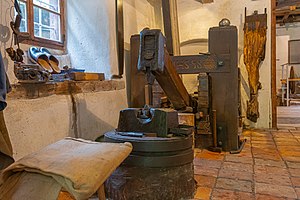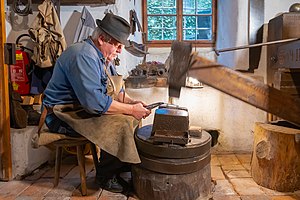
Back Martinet (farga) Catalan Hammerschmiede German Martelmaŝino EO Martinete (forja) Spanish Gabi EU چکش مکانیکی FA Hamari (laite) Finnish Martinet (industrie) French Maglio Italian Martinete Portuguese


A trip hammer, also known as a tilt hammer or helve hammer, is a massive powered hammer. Traditional uses of trip hammers include pounding, decorticating and polishing of grain in agriculture. In mining, trip hammers were used for crushing metal ores into small pieces, although a stamp mill was more usual for this. In finery forges they were used for drawing out blooms made from wrought iron into more workable bar iron. They were also used for fabricating various articles of wrought iron, latten (an early form of brass), steel and other metals.
One or more trip hammers were set up in a forge, also known variously as a hammer mill, hammer forge or hammer works. The hammers were usually raised by a cam and then released to fall under the force of gravity. Historically, trip hammers were often powered hydraulically by a water wheel.
Trip hammers are known to have been used in Imperial China since the Western Han dynasty. They also existed in the contemporary Greco-Roman world, with more evidence of their use in medieval Europe during the 12th century. During the Industrial Revolution the trip hammer fell out of favor and was replaced with the power hammer. Often multiple hammers were powered via a set of line shafts, pulleys and belts from a centrally located power supply.